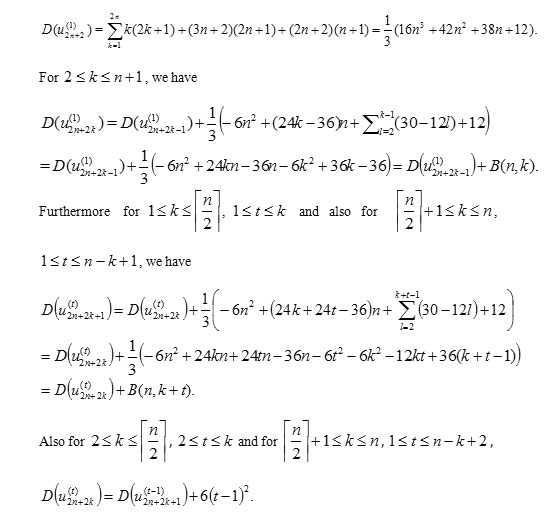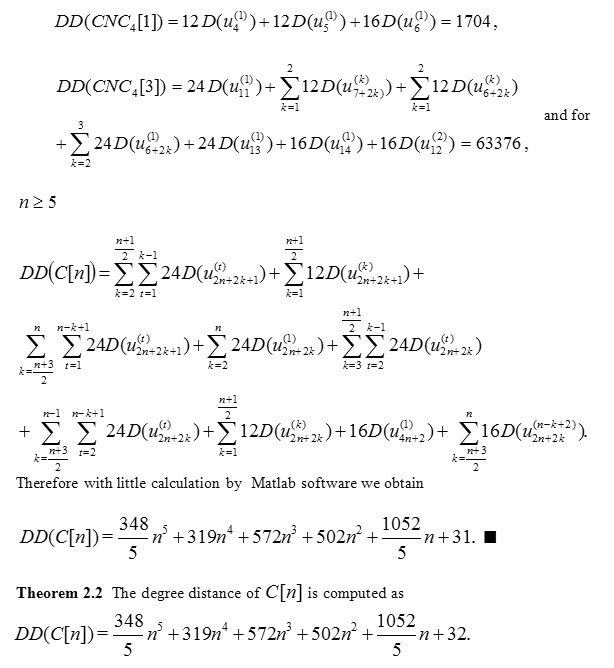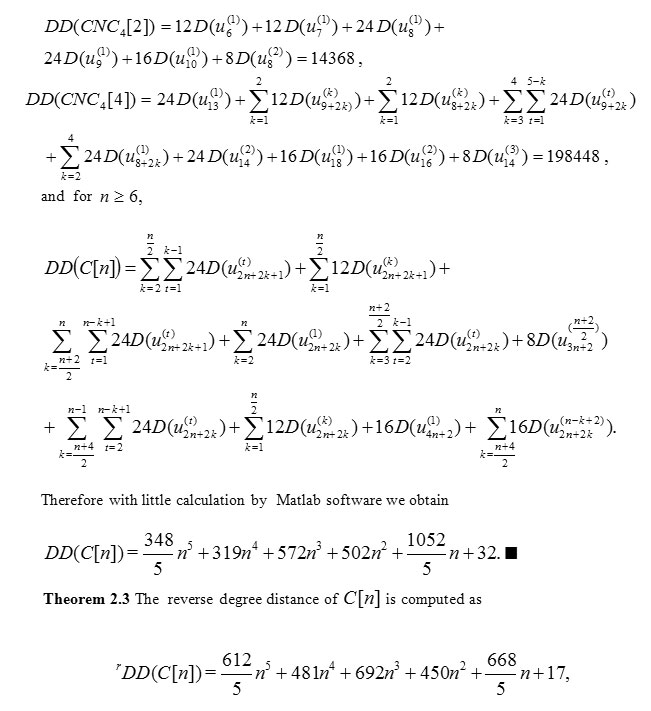Degree distance and reverse degree distance of one tetragonal carbon nanocones
Fereshteh Momen, Mehdi Alaeiyan*
Department of Mathematics, Karaj Branch, Islamic Azad University, Karaj, Iran
DOI : http://dx.doi.org/10.13005/ojc/310237
Article Received on :
Article Accepted on :
Article Published : 20 Jun 2015
Let be a simple connected graph with vertex and edge sets V(G) and E(G), respectively. The degree distance of G is defined as
![]() where deg(u) is the degree of u and D(u) = Σvεv d(u,v) is the sum of all distances from the vertex . The reverse degree distance is a connected graph invariant closely related to the degree distance proposed in the mathematical chemistry and it is defined as, DD(G) = 2q (p-1) Diam(G) - DD(G), Where p,q Diam(G) are the number of vertices, the number of edges and diameter of G, respectively. In this paper we comput the degree distance and reverse degree distance of one tetragonal carbon nanocones.
where deg(u) is the degree of u and D(u) = Σvεv d(u,v) is the sum of all distances from the vertex . The reverse degree distance is a connected graph invariant closely related to the degree distance proposed in the mathematical chemistry and it is defined as, DD(G) = 2q (p-1) Diam(G) - DD(G), Where p,q Diam(G) are the number of vertices, the number of edges and diameter of G, respectively. In this paper we comput the degree distance and reverse degree distance of one tetragonal carbon nanocones.
Carbon nanocones; degree distance; reverse degree distance; topological index
Download this article as:| Copy the following to cite this article: Momen F, Alaeiyan M. Degree distance and reverse degree distance of one tetragonal carbon nanocones. Orient J Chem 2015;31(2). |
| Copy the following to cite this URL: Momen F, Alaeiyan M. Degree distance and reverse degree distance of one tetragonal carbon nanocones. Available from: http://www.orientjchem.org/?p=9356 |
Introduction
A molecular graph is a simple graph such that its vertices correspond to the atoms and the edges to the bonds. A path of a length n in a graph G is a sequence of n+1 vertices such that from each of these vertices there is an edge to the next vertex in the sequence. Let G be a molecular graph, with the vertex and edge sets of which are represented by V(G) and E(G), respectively. The distance , d(u,v) is defined as the length of the shortest path between u and in G. D(u) denotes the sum of distances between and all other vertices of G. For a given vertex u of V(G) its eccentricity, ecc(u) is the largest distance between and any other vertex v of G.
![Table 1. Types of vertices of C[n]](http://www.orientjchem.org/wp-content/uploads/2015/06/Vol31_No2_Degr_Feres_T1-150x150.jpg) |
Table1: Types of vertices of C[n] Click here to View table |
The maximum eccentricity over all vertices G of is called the diameter of G and denoted by Diam(G) and the minimum eccentricity among the vertices of G is called radius of and denoted by R(G) .
![Table 2. Categorization of vertices of C[n]](http://www.orientjchem.org/wp-content/uploads/2015/06/Vol31_No2_Degr_Feres_T2-150x150.jpg) |
[Table2: Categorization of vertices of C[n |
Research into carbon nanocones (CNC) started almost at the same time as the discovery of carbon nanotubes (CNT) in 1991. Ball studied the closure of (CNT) and mentioned that (CNT) could sealed by a conical cap (1). The official report of the discovery of isolated CNC was made in , when Ge and Sattler reported their observations of carbon nanocones mixed together with tubules and a flat graphite surface (2). These are constructed from a graphene sheet by removing a 1200 wedge and joining the edges produces a cone with a single tetragonal defect at the apex.
Topological indices are graph invariants and are used for Quantitives Structure-Activity Relationship (QSAR) and Quantitives Structure-Property Relationship (QSPR ) studies (3,4). The Wiener index of a graph G denoted by W(G) is defined W(G) = 1/2 ΣvεV(G) D(u). The parameter DD(G) is called the degree distance G of and it was introduced by Dobrynin and Kochetova (5) and Gutman (6) as a graph – theoretical descriptor for characterizing alkanes; it can be considered as a weighted version of the Wiener index. It is defined as

When G is a tree on n vertices, it has been demonstrated the Wiener index and degree distance are closely related by DD(G) = 4W(G) – n (n-1). The reverse degree distance of the graph G is defined as ” DD(G) = 2q (p-1) Diam(G) – DD(G), where p,q are the number of vertices and the number of edges of G, respectively. Some properties of the reverse degree distance, especially for trees, have been given in (7, 8). There are two reasons for the study of this graph invariant. One is that the reverse degree distance itself is a topological index satisfying the basic requirement to be a branching index and with potential for application in chemistry (8). The other is the study of the reverse degree distance is actually the study of the degree distance, which is important in both mathematical chemistry and in discrete mathematics.
In this paper, we calculate the degree distance and reverse degree distance of one tetragonal carbon nanocones CNC4 [n].
Results and Discussion
The aim of this section is to comput the degree distance and reverse degree distance of one tetragonal carbon nanocones (C[n] = CNC4 [n]). To do this, the following lemmas are necessary.
Lemna 2.1 |V(C[n])| = 4(n+1)2, |E (C[n]) = 6n2 + 10n+4.
Proof. It is clear
In the following lemma, the diameter and radius of this nanocone are computed
Lemma 2.2 R (C[n]) = 2n+2 and Diam (C[n]) = 4n+ 2.
Proof. It is clear
The Lemma 2.2 shows that eccentricities of vertices of C[n] are veried between 2n+2 and 4n+2. Furthermore, we observe that there are two types of vertices in C[n]. 4n2 internal vertices of degree have eccentricities between 2n+2 and 4n and 4n external vertices of degree and 4n+4 external vertices of degree have eccentricities between 3n+2 and 4n+2. Now we use an algebraic method for computing the degree distance of one tetragonal carbon nanocones C[n]. when n is odd, the external vertices of C[n] are mad of n+1/2 types of vertices of degree with eccentricity equal to 3n+2k+2 and n+1/2 types of vertices of degree with eccentricity equal to 3n+2k+3 for 0 ≤ k ≤ n-1/2. But when n is even, the external vertices of C[n] are made of n/2 types of vertices of degree 3 with eccentricity equal to 3n+2k+3 for 0≤ k ≤ n-2/2 and also n+2/2 types of vertices of degree with eccentricity equal to 3n+2k+2 for 0≤ k ≤ n/2. from Figure , in one eight of C[n], when 1≤k≤|n/2|+1 there are k numbers of vertices and when |n/2|+2≤k≤n+1, there are n-k+2 numbers of vertices with eccentricity equal to 2n+2k. Similarly, when 1≤k≤n/2, k numbers and when |n/2|+1≤k≤n, n-k+1 numbers of vertices have eccentricity equal to 2n+2k+1, see Table . For computing the degree distance of one tetragonal carbon nanocones, at first we comput distance sum of all vertices. From Figure (left to right) if be t-th vertex of G with eccentricity equal to then we denote its distance sum by D(um(t)). Distance sum of all vertices of C[n] is computed in the following lemma.
Lemma 2.3 Distance sum of all vertices of C[n] is computed by two relations as:

proof. If u be a vertex of central tetragon with eccentricity equal to 2n+2 then for 1≤k≤2n, 2k+1 numbers of vertices have distances equal to k and also 3n+2 numbers of vertices have distances equal to 2n+1 and n+1 numbers of vertices have distances equal to 2n+2 form u. Thus

Now by using above relations alternatively this proof is completed.
![Figure 1. The notation of vertices of C[4]](http://www.orientjchem.org/wp-content/uploads/2015/06/Vol31_No2_Degr_Feres_Fig1-150x150.jpg) |
Figure1: The notation of vertices of C[4] Click here to View figure |
![Figure 2.The distance sum of vertices of C[4]](http://www.orientjchem.org/wp-content/uploads/2015/06/Vol31_No2_Degr_Feres_Fig2-150x150.jpg) |
Figure2: The distance sum of vertices of C[4] Click here to View figure |
Theorem 2.1 The degree distance of C[n] is computed as
DD ([n]) = 348/5n5 +319n4 +572n3 +502n2 + 1052/5 n+31,
where n≤1 is an odd number.
Proof. The distance sum of numbers of vertices is equals to D (u(k) 2n+2k), where 1≤k≤n+1/2. Similarly, the distance sum of numbers of vertices is equals to D (u(k) 2n+2k+1) where 1≤k≤n+1/2. Other vertices with the same distance sum are eight numbers. All vertices are of degree, except external vertices with eccentricity equal to 4n+2-k, , where their degrees are equal to 2, when O≤k≤n-1/2. See Table 2. Thus from Lemma 2.3 we have

where n≥2 is and even number.
Proof. The distance sum of numbers of vertices is equals to D(u(k)2n+2k). where 1≤k≤n+2/2. Similarly, the distance sum of 4 numbers of vertices is equals to D(u(k)2n+2k+1), where 1≤k≤n/2. These vertices are on the line L in Figure 2. Other vertices with the same distance sum are eight numbers. All vertices are of of degree 3 , except external vertices with eccentricity equal to 4n+2-k, where their degrees are 2 , when 0≤k≤n/2. See Table 2. Thus from Lemma 2.3 we have

where n≥1 is and odd number.
Proof. It is clear from Lemma 2.1 and Lemma 2.2 and Theorem 2.1.
Theorem 2.4 The reverse degree distance of

where n≥1 is an even number
Proof. It is clear from Lemma 2.1 and Lemma 2.2 and Theorem 2.2.
Refrences
- Ball, P., Needles in a carbon haystack, vol. 354., Nature, (1991).
- Ge, M., Sattler, K., Chem. Phys. Lett. 1994, 220, 192–196.
- Balaban, A. T., Gordon and Breach Science Publishers, The Netherlands, (1991).
- Gutman, I., Polansky, O.P., Mathematical Concepts in Organic Chemistry. Springer-Verlag, New York, (1986) .
- Dobrynin, A., Kochetova, A.A., J. Chem. Inf. Comput. Sci. 1994, 34, 1082–1086.
- Gutman, I., J.Chem. Inf. Comput. Sci. 1994, 34, 1087–1089.
- Tomescu, I., Discrete Math . 1999, 309, 2745–2748.
- Zhou, B., Trinjistic, N., J. Math. Chem . 2010, 47, 268–275.

This work is licensed under a Creative Commons Attribution 4.0 International License.









